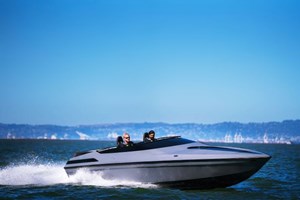News
Zero Emission Industries announces high-performance fuel cell powertrain system
Zero Emission Industries (ZEI) unveils FCV Vanguard, the world's first H2-powered high-performance speed boat, showcasing its new "Z-Class" prototype power system. This cutting-edge fuel cell system, designed to replace gas and diesel engines, was first implemented to repower a 1995 27-foot offshore speedboat.
By replacing a traditional gasoline big block V8 engine with a 375 horsepower, 465 lb-ft torque H2 fuel cell system, ZEI demonstrates that top-tier performance can coexist with environmental sustainability. The FCV Vanguard is developed in partnership with the California Energy Commission through their Gas R&D Program.
"With ZEI's H2 fuel cell system, we combine the best individual advantages of gasoline, diesel, and battery electric powertrains in a relatively small package," said John Motlow, Chief Strategy Officer of ZEI. "Our system delivers the high performance and quick refueling of gasoline engines, the torque and efficiency of diesel, and the clean, quiet operation of electric motors. This versatility makes it ideal for a wide range of applications, from high-speed boats to heavy-duty vehicles, all while producing zero emissions."
ZEI previously engineered and installed a similar power system on the world's first commercial passenger ferry in San Francisco, powered entirely by zero-emission H2 fuel cells. This system was a predecessor to the current generation of technology utilized in the FCV Vanguard.
"Moreover, optimized H2 storage tanks can extend the boat's range with a pathway to match gas or diesel and has much faster refueling than battery-only electrics," Motlow said. "The FCV Vanguard proves that H2 fuel cells can meet the rigorous demands of high-performance vehicles while providing a viable, zero-emission solution."
As the world races to meet ambitious climate and air quality targets, the focus often rests on developing, manufacturing, and distributing entirely new zero-emission vehicles, including battery electrics.
The FCV Vanguard highlights a more immediate and effective strategy to achieve climate goals: reusing existing vehicles, vessels, and equipment by replacing dirty, inefficient power sources (diesel and gas) with zero-emission fuel cell power systems.
"It is far more environmentally meaningful, immediate, and economically feasible to retrofit existing vehicles and vessels than to scrap them and manufacture entirely new ones," said Dr. Joe Pratt, CEO of ZEI. "By demonstrating a technically and commercially viable pathway for conversion, we've opened the door for every independent vehicle repair shop and boatyard to help their customers transition to zero emissions."
Consider the numbers: In the United States alone, there are approximately 13.5-MM commercial trucks on the road, with only about 500,000 new trucks sold annually. The vast majority of these vehicles have been in service for decades. Similar trends exist in the maritime industry, where retrofitting offers a sustainable and cost-effective alternative to replacement.
Impressive fuel cell system components and specifications. The prototype "Z-Class" fuel cell power system installed in the boat is more performant, flexible, and robust than comparable diesel, gasoline or battery-only electric motors. It includes four fuel cell stacks, a Li-Ion battery, H2 safety systems, a custom cooling system, power electronics and a high-performance electric motor, all controlled by ZEI's H2 operating software. The fuel cells run as needed to keep the battery charged and ready at all times; when needed, they work together to deliver electricity to an electric motor, which powers the prop. The system delivers remarkable performance metrics:
- Peak Power (10 Seconds): 390 KW (522 HP)
- Continuous Power: 280 kW (375 HP)
- Torque: 630 Nm (465 lb-ft)
- Dimensions: 1950 x 990 x 850 mm
- System Weight: 700 kg (1,540 lbs)
- Nominal System Efficiency: >50%
- Fuel Type: Gaseous H2
- Heat Management: Liquid-Cooled (Water-to-Water)
- Startup Time: Instantaneous.


